I remember watching several movies by Hayao Miyazaki and thinking “Wow, this would make a really good video game”. Particularly Nausicaä of the Valley of the Wind, with its spectacular clash of nature and machinery, and giant creatures that are not as bad as one would think. Aegis Defenders feels like a realisation of that potential, inviting players into a beautiful world and a thrilling adventure.
Aegis Defenders takes players on a journey through a post-apocalyptic world, reduced to ruin following an empire’s war with the gods themselves. The story follows Clu and her grandfather, Bart, a pair of Ruinhunters trying to make ends meet. Ruinhunters are adventurous types, and go delving deep into ruins (duh) to find relics from a bygone age. The pair soon find a sassy robot named Kobo, and this kicks off their epic cross-country odyssey to find Kobo’s long-dormant master. Along the way they pick up other adventurers, and try to stay under the radar of the evil Indra Empire.
It’s a straight-forward story, but one that is intriguing and told well. Characters are given room to grow, thanks to a branching dialogue tree, and the writing is witty and engaging. The game also knows the value of being subtle, slowly building the world and fleshing out the characters naturally. At no point was I bored of the dialogue, or clicking through it quickly, because the game wastes no time investing players in this world.
Gameplay skillfully combines platforming with tower defence, making for a diverse experience. Levels are divided into two phases, one is centred on exploring, and the other on defending a point. Exploration involves puzzle solving, light combat, and occasional sidetrips to collect minor relics. Players can swap between characters on the fly to leverage their unique skills, or their crafting abilities. For example, Bart can build blocks and turrets, and can also raise his hammer to block incoming foes. Clu is more nimble, and can air-dash and attack at range. Her crafting is trap-based, with recipes for bombs and spike-traps. Eventually, two other characters will join the party, bringing their own skills and abilities to the gameplay. Switching between characters feels a bit like the classic Blizzard game The Lost Vikings, and learning everyone’s quirks and strengths is crucial to progression. Exploring the ruined levels can actually be deeply relaxing, as the atmospheric music and gorgeous visuals draw you in.
The tower defence segments, however, are anything but relaxing, and quickly ramp the challenge up significantly. Each level ends in an arena with some plot-device at their centre – sometimes a relic to collect, other times a machine to shut down or activate. Regardless, players will have to scramble to collect resources and build up their defences to survive waves of hostile enemies. This can be overwhelming at first, but players will quickly adapt and learn to make the best of their crafting skills and the environment. These segments further highlight the importance of swapping characters, as some of the more powerful defences can only be built by combining recipes. Characters spend time between levels at a campsite. Here, Clu can talk with others, upgrade weapons, or buy new crafting recipes. In terms of pacing, it offers a good respite after the chaotic tower defence, as well as more dialogue chains.
One of the best words to describe Aegis Defenders would be subtle. Aside from tutorial prompts and occasional pop-ups, the game is largely content with players learning things for themselves. The level design is built around this sense of guided discovery, and it gently pushes players to experiment with the quirks of a new system and learn its applications. The exploration phase of a level spends time introducing new gameplay concepts, like falling stalactites, moveable platforms, or how to use one enemy to damage another. The defence phase then throws all these new concepts into an arena and tests how well the players can adapt them into strategies. Overall, the level design is excellent, and the game rewards players for studying new features and learning how to use them.
There’s a lot to love with Aegis Defenders, and there isn’t much that detracts from it. The tower defence and subtle puzzles caused some frustration at first, but once a player adjusts to the particular nature of the game many gripes fall away. Truly, it comes down to player preference, and whether or not you feel that another retro-inspired pixel art side-scroller can be worth your time. I encountered an issue with the Xbox 360 controller cutting out all audio, but I’m told that’s more of a Windows 10 fault. Fortunately, the game plays just fine on keyboard.
I should also mention that Aegis Defenders supports splitscreen co-op, but I never got a chance to try that out. This meant that I was forced to resort to the most unreliable of teammates: myself. However, the game feels like it was built around the tactic of positioning a character where their AI can do the most good, then swapping to a different one. It just adds to the thrilling feel of combat, quickly swapping back and forth to repel an attack or desperately build turrets.
Whatever your thoughts about indie games may be, Aegis Defenders is an engrossing, stylish, and charming adventure through a rich and realised world. The game challenges you to learn its secrets and master them, and the music and visuals are just plain gorgeous. It’s a thrilling game alone, and I imagine having Player Two along for the ride could be a blast.
Last Updated: February 12, 2018
| Aegis Defenders | |
|
Aegis Defenders comes highly recommended. The level design is inspired, challenging players to adapt their playstyle on the fly, and the gameplay is riveting and enjoyable. And it's all just so charming, with vibrant characters, witty dialogue, and a story that unfolds at a natural pace.
|
|
|---|---|
| Aegis Defenders was reviewed on PC | |
|
76 /
100
| |

























